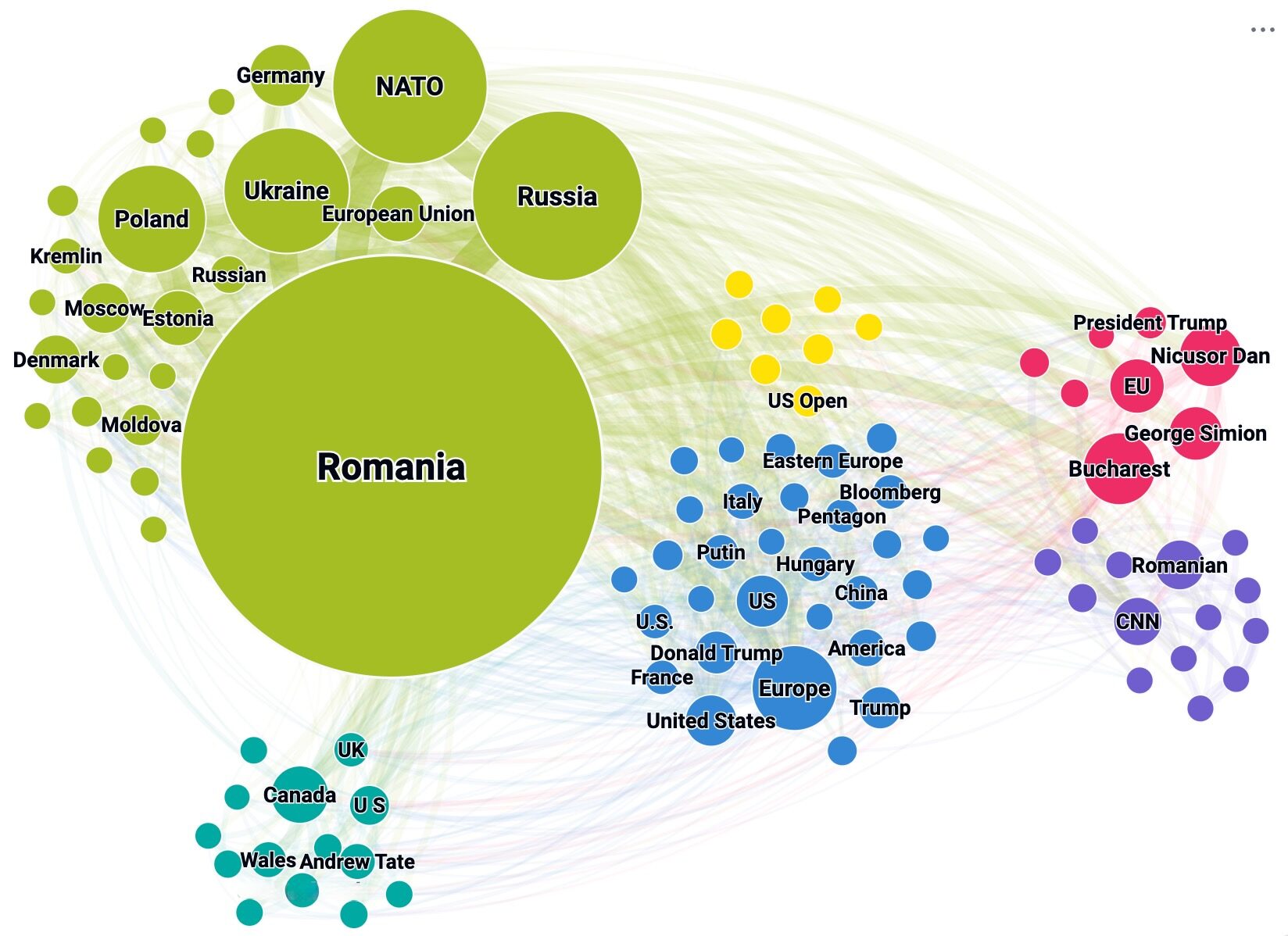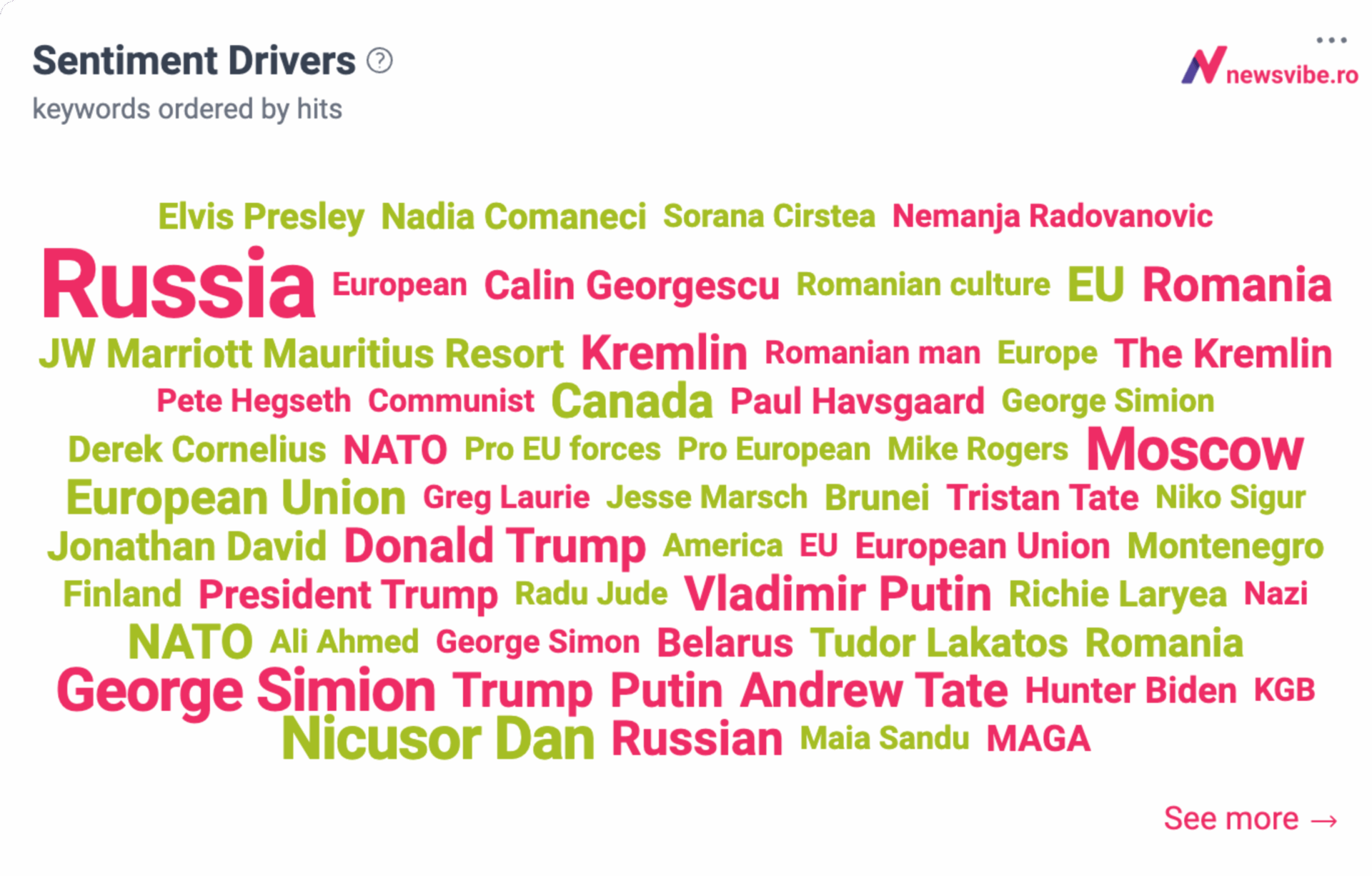Part 1: The Hidden Structure (The Network Map)
First, we needed to understand the structure. We used NewsVibe’s Semantic Network Analysis feature to visualize which concepts and personalities are mentioned together. The map below shows these connections:
-
The geopolitical frontline (green cluster): This is, by far, the largest cluster. Here, “Romania” is connected to “Poland”, “Ukraine”, “NATO” and “Russia”. This narrative is driven by hard security news, such as Russian drone incidents near Romania’s border and NATO’s “Eastern Sentry” response. In this story, Romania is a key strategic frontline state.
-
The political connection (blue/red clusters): A second universe links US domestic politics to Romania’s. American entities like “President Trump” and the “Pentagon” (a reference to US troop debates) are connected to local figures like “Nicusor Dan” and “George Simion.” The context is Dan’s “pro-Western” victory in the May 2025 election, contrasted with “sovereigntist” narratives.
-
The isolated scandal (turquoise cluster): Completely separate from geopolitics or local politics, a dedicated cluster lives on for the “Andrew Tate” scandal. This has its own media ecosystem and audience, functioning as a self-contained, high-profile legal story.

Part 2: The Emotional Charge (Sentiment Analysis)
If the network map showed us the structure, the next step was to understand the emotion. How are these stories being told? For this, we used NewsVibe’s Sentiment Drivers feature, which identifies the tone at an entity level.
- The geopolitical story is a polarized conflict: The narrative is tense, with strongly negative entities (e.g., Russia, Vladimir Putin, Kremlin) in direct opposition to positive ones (e.g., NATO, European Union).
- The political story is value-charged: This isn’t neutral reporting. Nicusor Dan’s victory is framed positively (green), while figures associated with the sovereigntist movement, like George Simion or Calin Georgescu, seem to drive mostly negative sentiment (red) in US media.
- The scandal is unequivocally negative: As expected, Andrew Tate and Tristan Tate are entities that drive overwhelmingly negative sentiment.

Part 3: The Hidden Opportunities (The Positive Ambassadors)
This sentiment analysis also shows us who manages to “cut through” the political and scandalous noise. While negative narratives dominate in volume, “ambassadors” exist who consistently generate positive sentiment.
Our data shows that cultural and sports figures like Nadia Comaneci, Sorana Cirstea, or film director Radu Jude, as well as concepts like Romanian culture are consistently mentioned in positive contexts.
Furthermore, we can spot brand and tourism opportunities.
The Strategic Takeaway: Use Media Intelligence to Distinguish Risk from Opportunity
How do you manage a crisis or an opportunity when public perception is fractured into dozens of parallel conversations?
The answer is to use a media intelligence platform that can map these nuances in real-time.
An agile tool like NewsVibe is essential because it allows you to discover the connections beneath the surface. It maps the hidden conversational structures (what is being discussed in context) and their precise sentiment (the emotional charge). Only then can you strategically distinguish a contained risk from a systemic crisis, or identify a communication opportunity before it becomes obvious.
Our platform uses proprietary algorithms and LLMs to handle advanced Natural Language Processing, semantic network analysis, complex sentiment analysis and many more features. We empower leaders and communicators to cut through the noise, identify relevant insights faster and strategically distinguish between systemic risks and new opportunities.
